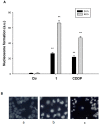A Pt(IV) Prodrug Combining Chlorambucil and Cisplatin: a Dual-Acting Weapon for Targeting DNA in Cancer Cells
- PMID: 30486477
- PMCID: PMC6321036
- DOI: 10.3390/ijms19123775
A Pt(IV) Prodrug Combining Chlorambucil and Cisplatin: a Dual-Acting Weapon for Targeting DNA in Cancer Cells
Abstract
In this study, two DNA-targeting agents, cisplatin and chlorambucil, were combined in a Pt(IV) prodrug, 1, which was thoroughly characterized by means of spectroscopic and spectrometric techniques. Tested towards a panel of various human tumor cell lines, this compound showed superior in vitro antitumor potential than the reference drug cisplatin. In addition, an antitumor potential of 1 was found, which is comparable to that of oxaliplatin in 3D spheroid models of colon cancer cells. Mechanistic studies performed in colon cancer cells confirmed that the conjugation of chlorambucil to Pt(IV) cisplatin-based scaffold tunes the lipophilicity of the prodrug, consequently improving the ability of the compound to accumulate into cancer cells and to target DNA, ultimately leading to apoptotic cancer cell death.
Keywords: Pt(IV) prodrugs; chlorambucil; cisplatin; cytotoxicity.
Conflict of interest statement
The authors declare no conflicts of interest.
Figures






Similar articles
-
Chlorambucil-conjugated platinum(IV) prodrugs to treat triple-negative breast cancer in vitro and in vivo.Eur J Med Chem. 2018 Sep 5;157:1292-1299. doi: 10.1016/j.ejmech.2018.08.065. Epub 2018 Aug 27. Eur J Med Chem. 2018. PMID: 30195239
-
Conjugation of platinum(IV) complexes with chlorambucil to overcome cisplatin resistance via a "joint action" mode toward DNA.Eur J Med Chem. 2017 Sep 8;137:167-175. doi: 10.1016/j.ejmech.2017.05.056. Epub 2017 May 28. Eur J Med Chem. 2017. PMID: 28586717
-
Monochalcoplatin: An Actively Transported, Quickly Reducible, and Highly Potent PtIV Anticancer Prodrug.Angew Chem Int Ed Engl. 2018 Jul 16;57(29):9098-9102. doi: 10.1002/anie.201804314. Epub 2018 Jun 14. Angew Chem Int Ed Engl. 2018. PMID: 29806087
-
Pt(IV) Prodrug Photoactivation: A Promising Strategy for Cancer Therapy.Curr Protein Pept Sci. 2024;25(10):797-813. doi: 10.2174/0113892037297416240525155628. Curr Protein Pept Sci. 2024. PMID: 38919078 Review.
-
Pt(IV) antitumor prodrugs: dogmas, paradigms, and realities.Dalton Trans. 2022 Feb 8;51(6):2121-2134. doi: 10.1039/d1dt03886a. Dalton Trans. 2022. PMID: 35015025 Review.
Cited by
-
Click Pt(IV)-Carbohydrates Pro-Drugs for Treatment of Osteosarcoma.Front Chem. 2021 Dec 7;9:795997. doi: 10.3389/fchem.2021.795997. eCollection 2021. Front Chem. 2021. PMID: 34950638 Free PMC article.
-
Chlorambucil-Bearing Hybrid Molecules in the Development of Potential Anticancer Agents.Molecules. 2023 Sep 30;28(19):6889. doi: 10.3390/molecules28196889. Molecules. 2023. PMID: 37836732 Free PMC article. Review.
-
Gd(iii)-Pt(iv) theranostic contrast agents for tandem MR imaging and chemotherapy.Chem Sci. 2020 Jan 28;11(9):2524-2530. doi: 10.1039/c9sc05937g. Chem Sci. 2020. PMID: 34084418 Free PMC article.
-
Genotoxic potential of a novel PDE-4B inhibitor Apremilast by chromosomal aberration and micronucleus assay in mice.Saudi Pharm J. 2020 May;28(5):615-620. doi: 10.1016/j.jsps.2020.03.014. Epub 2020 Apr 2. Saudi Pharm J. 2020. PMID: 32435143 Free PMC article.
-
Bioactive Platinum(IV) Complexes Incorporating Halogenated Phenylacetates.Molecules. 2022 Oct 21;27(20):7120. doi: 10.3390/molecules27207120. Molecules. 2022. PMID: 36296713 Free PMC article.
References
-
- Hannon M.J. Metal-based anticancer drugs: From a Past Anchored in nPlatinum hemistry to a post-genomic future of diverse chemistry and biology. Pure Appl. Chem. 2007;79:2243–2261. doi: 10.1351/pac200779122243. - DOI
-
- Siegel A., Sigel H. Metal Ions in Biological Systems Vol. 42 Metal Complexes in Tumour Diagnosis and as Anticancer Agents. CRC Press; New York, NY, USA: 2004. pp. 251–296. Chapter 8.
MeSH terms
Substances
LinkOut - more resources
Full Text Sources

